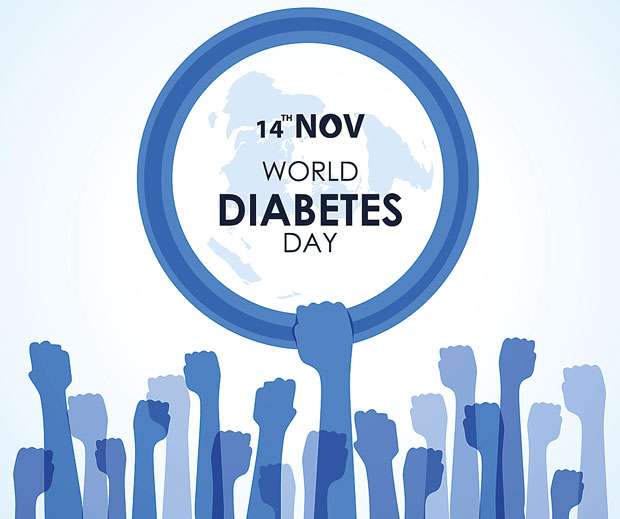Reply To:
Name - Reply Comment

 Diabetes has become a household name in recent times and is now a global pandemic. Ironically, the more familiar it has become, that the attitude towards it remains passive. The impact of diabetes is vastly underestimated among the common people. In fact, diabetes is being accepted as an inevitable condition that has to be faced as one ages. On the contrary, under the benign cloak of ‘typical old age illness’ hides a chronic debilitating illness that cripples one’s physical, mental, and social wellbeing. It also places a long term financial burden on the patient and his or her immediate family. Diabetes is largely preventable by adhering to a certain lifestyle and prevention. This process is better than cure especially in the absence of cure.
Diabetes has become a household name in recent times and is now a global pandemic. Ironically, the more familiar it has become, that the attitude towards it remains passive. The impact of diabetes is vastly underestimated among the common people. In fact, diabetes is being accepted as an inevitable condition that has to be faced as one ages. On the contrary, under the benign cloak of ‘typical old age illness’ hides a chronic debilitating illness that cripples one’s physical, mental, and social wellbeing. It also places a long term financial burden on the patient and his or her immediate family. Diabetes is largely preventable by adhering to a certain lifestyle and prevention. This process is better than cure especially in the absence of cure.
November 14 marks World Diabetes Day. It is also the birthday of Sir Fredrick Banting, who co-discovered Insulin along with Charles Best in 1922. The International Diabetes Federation (IDF) and the World Health Organization (WHO) commemorate this day annually ‘in response to growing concerns about the escalating health threat posed by diabetes’. The campaign ‘draws attention to issues of paramount importance to the diabetes world and keeps diabetes firmly in the public and political spotlight.’ Each year, the World Diabetes Day focuses on a particular cause, and for the year 2018-2019, the theme “family and diabetes” has been announced.
Diabetes is largely preventable by adhering to a certain lifestyle and prevention. This process is better than cure especially in the absence of cure
According to the International Diabetes Federation (IDF), a two-year timeframe has been chosen to best facilitate planning, development, promotion and participation. Materials and actions that IDF will develop over the two years of the campaign will aim at raising awareness of the impact that diabetes has on the family and support the network of those affected. They will also help to promote the role of the family in the management, care, prevention and education of diabetes.
Diabetes is a disease, or rather, a group of metabolic diseases characterised by high levels of blood glucose. Understanding the underlying pathophysiology of diabetes is vital. The food we eat consist of carbohydrates and in order for the body to utilise the consumed carbohydrates, it first has to be broken down to Glucose, a simplified form. Glucose is an important source of energy for body tissues, and it is the main source of fuel to the brain. Insulin is a hormone produced by the pancreas. The role of this hormone is vital in carbohydrate metabolism, as it circulates in the blood stream, enabling the glucose to be utilised by the body cells. Once absorbed and used, excess glucose would be stored in the liver, for future use, as a back-up fuel source. In instances where the blood glucose is low, the liver contributes to maintain the blood glucose within the normal range. In diabetic patients, the insulin production is inadequate, hence, unable to be utilised by the body cells, glucose accumulates in the bloodstream. This results in high blood sugar. In some instances, insulin production is adequate yet the body cells fail to recognise and respond to the hormone. Consistently high levels of blood sugar, gradually begins to take a toll and damages tissues and causes failure of various organs.
Type 1 Diabetes also known as juvenile onset diabetes, type 2 diabetes which is also known as adult onset diabetes and gestational diabetes that occurs during the pregnancy period are the three main types of diabetes. Type 1 or juvenile onset diabetes cannot be prevented and occurs due to an autoimmune reaction where one’s own immune system destroys the insulin producing cells, due to reasons yet unknown. This type manifests in children and young adults, requiring them to be dependent on insulin injections throughout their lives. The second type amounts to 90% of the diabetes cases in the world. Type 2 diabetes may manifest at any stage of adulthood and develops due to insulin deficiency or resistance to insulin. It may remain undetected in many, and almost always presents in obese or overweight individuals. This type can be managed in the early stages through lifestyle modification, however oral drugs and insulin would be required, depending on the extent and progression of the disease. Gestational diabetes occurs during pregnancy and is associated with complications to both the mother and the child. The condition resolves spontaneously after pregnancy. The mother and child are at a risk for acquiring type 2 diabetes later in life and must manage their lifestyle accordingly.
Approximately 425 million known cases of diabetes prevail as of 2018 and this number is expected to increase radically by 2030. In addition to the adverse health outcomes, diabetes places an emotional and financial burden on the family members of patients. Family members of the patient have often been noted to alter their lifestyles and food habits to accommodate the patient. Being a chronic disease that requires medications, regular checkups and specific food habits over prolonged periods of time have made diabetes an expensive disease that needs to be prevented to avoid the loss of quality in life.
Realising that diabetes just doesn’t affect an individual alone, but affects everybody associated with his/her family, can be the first step to prompt people to be more aware and cautious. Families are the building blocks of the society. Families being burdened with chronic illnesses and having to battle the cascade of emotional and economic consequences cripples the society as a whole. Every little effort to alter lifestyles and raise awareness taken by a proactive individual to combat diabetes will in the long-run eradicate this pandemic.
Credits: International Diabetes Federation, worlddiabetesday.org